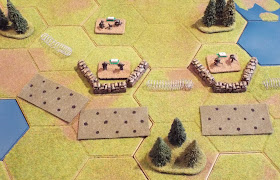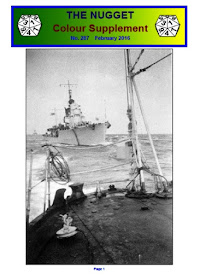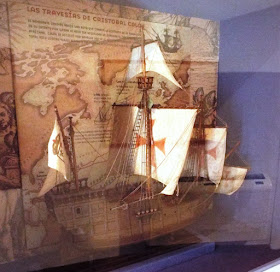At exactly 8.00am, troops from SPUR's Armed Forces began to move forward to attack the Opelandic defences in the left-centre sector.
The Terrain
The Defenders
The defenders (commanded by Colonel Ore Jonasson) comprised:
The Attackers
The attackers (commanded by DivCom Litvinoff) comprised:
At precisely 8.00am, the leading SPUR Rifle Units (accompanied by a Mortar Unit and an Anti-tank Gun Unit) advanced up to the border ...
Turn 2
... and then crossed into Opeland.
Turn 3
SPUR's Mortar Unit fired at the nearest Opelandic strong point, but although its shells hit the strong point, the Opelanders inside it suffered not casualties.
Both the left and right-hand SPUR Rifle Units advanced into the minefields in front of them ...
... with disastrous consequences for each of them as both suffered casualties.
The central SPUR Rifle Unit moved through the forest and was confronted by barbed wire, which stopped any further advance for the moment.
In the fighting that ensued ...
... the left and right-hand SPUR Rifle Units were forced to retreat, ...
... whilst the central one was unable to take part as it was trying to clear the barbed wire.
It did come under attack from both Opelandic strong points, and was forced to fall back into the forest.
Turn 4
An artillery duel took place, but the fire from the SPUR Mortar and Anti-tank Gun Units failed to do any damage to the Opelandic strong points.
The Opelandic Mortar Unit did manage to hit the left-hand SPUR Rifle Unit, causing it further casualties and reducing it to a quarter of its original strength.
The central and right-hand SPUR Rifle Units attempted to attack the Opelandic strong point again ...
... but both fell foul of the minefields and suffered casualties.
The fighting around the strong points was fierce, but yet again the SPUR Rifle Units failed to break into the Opelandic defences, and were forced to withdraw.
Turn 5
Both sides continued the artillery duel, but their fire was generally ineffective and neither side suffered any casualties.
The second wave of SPUR troops arrived (three Rifle Units and a Light Field Artillery Unit), and advanced towards the Opelandic defences.
Turn 6
The arrival of the Light Field Artillery Unit added considerable weight to the fire directed at the Opelandic strong points, and for the first time the Opelanders suffered casualties.
The exchange was not all one way, and the left-hand SPUR Rifle Unit was hit by Opelandic Mortar fire and destroyed.
The newly-arrive SPUR Rifle Units charged forward, and two of them entered the Opelandic minefields ...
... which resulted in both Units suffering casualties.
They were not deterred by these loses, and assaulted the Opelandic strong points. In one instance this resulted in further Opelandic losses, ...
... but the other assault was a catastrophic failure ...
... which resulted in the total destruction of the attacking SPUR Rifle Unit.
Turn 7
At this point it became very apparent that the human wave attacks that were being used were doomed to failure. The Attacking Units were exhausted, and withdrew to position that were just inside the border.
As night fell DivCom Litvinoff was summoned to Marshall Zirkoff's Headquarters to explain why his attack had failed. It was not an interview that he looked forward to having.
The Terrain
The Defenders
The defenders (commanded by Colonel Ore Jonasson) comprised:
- 2 x Regular Infantry Units
- 1 x Regular Mortar Unit
The Attackers
The attackers (commanded by DivCom Litvinoff) comprised:
- 6 x Rifle Units
- 1 x Mortar Unit
- 1 x Anti-tank Gun Unit
- 1 x Light Field Artillery Unit
At precisely 8.00am, the leading SPUR Rifle Units (accompanied by a Mortar Unit and an Anti-tank Gun Unit) advanced up to the border ...
Turn 2
... and then crossed into Opeland.
Turn 3
SPUR's Mortar Unit fired at the nearest Opelandic strong point, but although its shells hit the strong point, the Opelanders inside it suffered not casualties.
Both the left and right-hand SPUR Rifle Units advanced into the minefields in front of them ...
... with disastrous consequences for each of them as both suffered casualties.
The central SPUR Rifle Unit moved through the forest and was confronted by barbed wire, which stopped any further advance for the moment.
In the fighting that ensued ...
... the left and right-hand SPUR Rifle Units were forced to retreat, ...
... whilst the central one was unable to take part as it was trying to clear the barbed wire.
It did come under attack from both Opelandic strong points, and was forced to fall back into the forest.
Turn 4
An artillery duel took place, but the fire from the SPUR Mortar and Anti-tank Gun Units failed to do any damage to the Opelandic strong points.
The Opelandic Mortar Unit did manage to hit the left-hand SPUR Rifle Unit, causing it further casualties and reducing it to a quarter of its original strength.
The central and right-hand SPUR Rifle Units attempted to attack the Opelandic strong point again ...
... but both fell foul of the minefields and suffered casualties.
The fighting around the strong points was fierce, but yet again the SPUR Rifle Units failed to break into the Opelandic defences, and were forced to withdraw.
Turn 5
Both sides continued the artillery duel, but their fire was generally ineffective and neither side suffered any casualties.
The second wave of SPUR troops arrived (three Rifle Units and a Light Field Artillery Unit), and advanced towards the Opelandic defences.
Turn 6
The arrival of the Light Field Artillery Unit added considerable weight to the fire directed at the Opelandic strong points, and for the first time the Opelanders suffered casualties.
The exchange was not all one way, and the left-hand SPUR Rifle Unit was hit by Opelandic Mortar fire and destroyed.
The newly-arrive SPUR Rifle Units charged forward, and two of them entered the Opelandic minefields ...
... which resulted in both Units suffering casualties.
They were not deterred by these loses, and assaulted the Opelandic strong points. In one instance this resulted in further Opelandic losses, ...
... but the other assault was a catastrophic failure ...
... which resulted in the total destruction of the attacking SPUR Rifle Unit.
Turn 7
At this point it became very apparent that the human wave attacks that were being used were doomed to failure. The Attacking Units were exhausted, and withdrew to position that were just inside the border.
As night fell DivCom Litvinoff was summoned to Marshall Zirkoff's Headquarters to explain why his attack had failed. It was not an interview that he looked forward to having.


























































